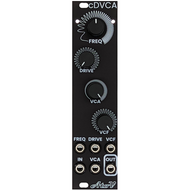cDVCA - AtoVproject
by Ian Rapp
AtoVproject is a Berlin-based company whose previous two modules have some pretty interesting qualities and design ideas, and their third release, cDVCA, follows in those footsteps.
cDVCA or “class-D” VCA is a unique VCA based on class-D amplification technology. That’s cool, but what is class D? Heck, what’s class A or B for that matter? For the purposes of this article, more or less, the differences in class types is that a class A design has high fidelity but low efficiency in terms of its operation, Class B has more efficiency but a lot of distortion, class AB has the best of the two with decent efficiency and fidelity, and Class D has the best efficiency buy isn’t necessarily high fidelity sounding. This means that Class D designs run cooler and overall, are lighter in weight and size than either a class A,B, or AB amps.
Developed in the 1950s, recent technology has seen improved fidelity for class D quite a bit, so that with the smaller footprint and lower excess heat output, your amp can potentially power the same speakers as one of the other classes but will be smaller, cooler, and less expensive than its counterparts, though, of course it depends on other factors like build quality, build location, etc.
I’d never come across a class D amp circuit in a Eurorack module up until this point, and AtoVprojects touts this as “The World’s First” class D VCA, so I was curious to see if it mattered, if I could hear a difference in sound and if it was unique enough for me to care. Sometimes it’s easy to lose the forest for the trees as the saying goes, and just because something is new or different doesn’t mean it’s better or worth the effort. Heck, I have a whole constant internal dialogue about this exact thought when it comes to scientific progresses, but still, I was pretty interested to try this as cDVCA has other interesting features like waveshaping capabilities, a drive circuit, and even has an onboard 1-pole filter. That’s a lot for a module that only stands at 6HP.
En bref, Class D amplification takes an input signal and transforms it into an ultrasonic [34kHz] pulse-width modulation signal which is thereby used to determine the amplitude of the signal. When nothing is patched into the input of cDVCA that very PWM—which, again, is the determination of the amplification and not the input signal—can then be brought into audio rate, tamed with its 1V/oct input, and suddenly cDVCA becomes a sound source. This method of turning cDVCA into a sound source can create some wacked-out, unusual waveshaping and with the VCA and VCF onboard, cDVCA is essentially a synth voice. Pretty cool. On top of this, there’s a pretty unique sounding clipping drive to further color the sound and give your signal some grit. The filter is pretty handy because cDVCA can get harsh, and treble heavy, so it’s nice to be able to tone that down.
Throwing a drum track through cDVCA produced an acid-y blown out track, and I’ve not heard distortion on rhythm tracks quite like this. It was more fuzzy than distorted, but the heart was still there, you could hear all of the components, as it didn’t get squashed into a slightly aerobic drone the way some distortions will do.
Using the internal drive circuit to beef up a simple triangle wave melody worked well on the lower registers, but got a little lost in the highs—not atypical—and CVing the frequency of cDVCA brought some interesting timbres.
The understated aesthetic of cDVCA underscores the versatility and sound shaping possibilities that lie within. It’s a pretty fun and interesting sounding module whose simplicity in terms of controls contrasts nicely with its unique design implementation. You might not notice the difference between a “normal” class A,B, or A/B VCA and this class D VCA, but…you might, and it’s definitely worth checking out to see if you do. I had a lot of fun with this, mostly processing drums through it. The interplay between the Frequency and the Drive brought out some really nasty, and highly appreciated, harmonics. But whether you use it to slaughter beats, as a synth voice, or just a VCA with some extra bits and bobs, cDVCA is a really versatile module that’s got its own voice, one which stands out quite well.
14 HP +12v 40mA -12v 40mA
Price: $263


